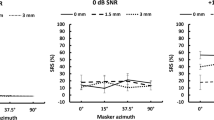Abstract
The Binaural Masking-Level Difference phenomenon occurs both in listeners with normal hearing and with sensorineural hearing loss (SNHL). Previous studies of BMLDs involving SNHL listeners used a 500- or 2000-Hz pure tone as the target signal, but the BMLD performance of SNHL listeners with stimulus amplified for other frequencies has not been reported previously. Therefore, this study aimed to measure the BMLD in SNHL listeners at various frequencies after amplification by hearing aids. Thirty subjects with mild to moderately severe SNHL participated in the experiments. The BMLDs were measured based on the detection threshold differences for pure tones of 125, 250, 500, 1000, and 2000 Hz in the presence of white noise when presented interaurally in phase (S0N0) and interaurally in antiphase (SπN0). The results show that when using white noise as a masker, the average detection thresholds for the target signals were significantly lower in the SπN0 condition compared to those in the S0N0 condition (p < 0.001). The SNHL subjects had mean BMLDs of 2.3, 4.8, 4.7, 4.2, and 3.7 dB at 125, 250, 500, 1000, and 2000 Hz, respectively. The results obtained in the present study provide preliminary support that SNHL listeners hear target signals easier in noisy environments when the signals are amplified by hearing aids and presented in antiphase.




Similar content being viewed by others
References
Moore, B. C. J. (2003). An introduction to the psychology of hearing. California: Academic Press.
Hirsh, I. J. (1948). The influence of interaural phase on interaural summation and inhibition. Journal of the Acoustic Society of America, 20(4), 536–544.
Blauert, J., & Allen, J. (1997). Spatial hearing: the psychophysics of human sound localization. Boston: The MIT Press.
Quaranta, A., & Cervellera, G. (1974). Masking level difference in normal and pathological ears. International Journal of Audiology, 13(5), 428–431.
Jerger, J., Brown, D., & Smith, S. (1984). Effect of peripheral hearing loss on the masking level difference. Archives of Otolaryngology, 110(5), 290–296.
Hall, J. W., & Harvey, A. D. (1985). The binaural masking level difference as a function of frequency, masker level and masking bandwidth in normal-hearing and hearing-impaired listeners. International Journal of Audiology, 24(1), 25–31.
Dillon, H. (2012). Hearing aids. New York: Thieme.
Nabelek, A. K. (2005). Acceptance of background noise may be key to successful fittings. The Hearing Journal, 58(4), 10–15.
Kochkin, S. (2002). 10-year customer satisfaction trends in the US hearing instrument market. Hearing Review, 9(10), 14–25.
Picou, E. M., & Ricketts, T. A. (2011). Comparison of wireless and acoustic hearing aid-based telephone listening strategies. Ear and Hearing, 32(2), 209–220.
Galster, J. A. (2010). A new method for wireless connectivity in hearing aids. The Hearing Journal, 63(10), 36–38.
Sandrock, C., & Schum, D. J. (2007). Wireless transmission of speech and data to, from, and between hearing aids. The Hearing Journal, 60(11), 12–16.
American National Standards Institute. (2004). ANSI S3.6: Specification for audiometers. New York: American National Standards Institute.
Kramer, S. J. (2014). Audiology: Science to practice (2nd ed.). San Diego, CA: Plural Publishing.
Valente, M. (2009). Pure-tone audiometry and masking. San Diego, CA: Plural Pub.
Kong, Y. Y., & Zeng, F. G. (2006). Temporal and spectral cues in Mandarin tone recognition. Journal of the Acoustic Society of America, 120, 2830–2840.
Ho, C.-Y., Li, P.-C., Chiang, Y.-C., Young, S.-T., & Chu, W.-C. (2015). The binaural masking-level difference of Mandarin tone detection and the binaural intelligibility-level difference of Mandarin tone recognition in the presence of speech-spectrum noise. PLoS One, 10(4), e0120977. doi:10.1371/journal.pone.0120977.
Levitt, H. (1971). Transformed up-down methods in psychoacoustics. Journal of the Acoustic Society of America, 49(2), 467–477.
Moore, B. C. J. (2007). Cochlear hearing loss: Physiological, psychological and technical issues. Chichester: Wiley.
Ciletti, L., & Flamme, G. A. (2008). Prevalence of hearing impairment by gender and audiometric configuration: Results from the national health and nutrition examination survey (1999–2004) and the Keokuk County rural health study (1994–1998). Journal of the American Academy of Audiology, 19(9), 672–685.
Jung, D. J., Lee, K.-Y., Lee, S. H., & Jang, J. H. (2015). Comparative analyses between receiver in the canal hearing aids and closed fit hearing aids: Preliminary study. Korean Journal of Otorhinolaryngology-Head and Neck Surgery, 58(4), 249–256.
Winkler, A., Latzel, M., & Holube, I. (2016). Open versus closed hearing-aid fittings: A literature review of both fitting approaches. Trends in Hearing, 20, 1–13. doi:10.1177/2331216516631741.
Magnusson, L., Claesson, A., Persson, M., & Tengstrand, T. (2013). Speech recognition in noise using bilateral open-fit hearing aids: The limited benefit of directional microphones and noise reduction. International Journal Of Audiology, 52(1), 29–36. doi:10.3109/14992027.2012.707335.
Acknowledgments
The authors would like to thank the audiologists working in the Department of Otolaryngology-Head and Neck Surgery of Tri-Service General Hospital, the subjects who participated in this study, and Chun-Yen Chiang, who helped to design the circuitry of the inverter and adders. The authors would also like to thank Chien-Leng Chen for supporting the statistical analysis. This work was supported by a grant from the National Science Council of Taiwan (NSC 101-2220-E-715 -001).
Author information
Authors and Affiliations
Corresponding authors
Rights and permissions
About this article
Cite this article
Ho, CY., Li, PC., Young, ST. et al. Preliminary Measurements of Binaural Masking-Level Difference When Using Hearing Aids for Sensorineural Hearing Loss. J. Med. Biol. Eng. 36, 668–674 (2016). https://doi.org/10.1007/s40846-016-0174-4
Received:
Accepted:
Published:
Issue Date:
DOI: https://doi.org/10.1007/s40846-016-0174-4




